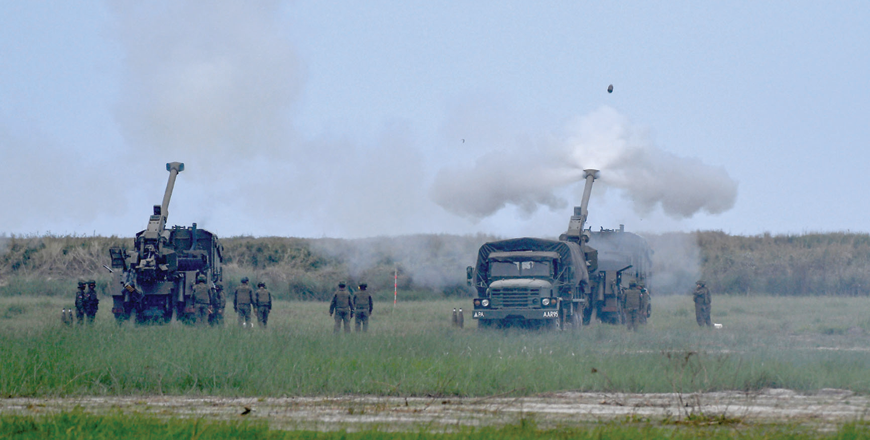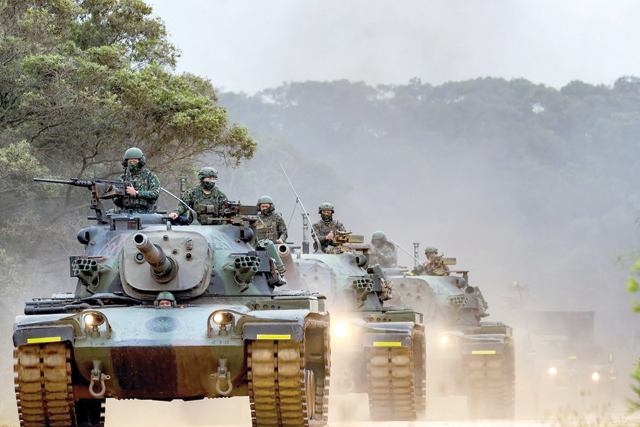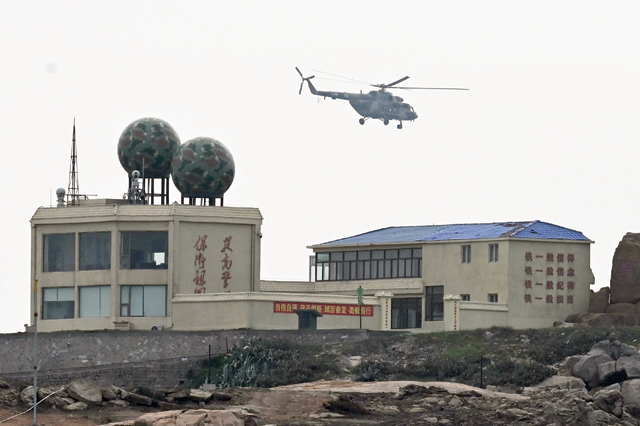You are here
Taiwan to prepare for Chinese blockade in annual war drills
By AFP - Apr 26,2023 - Last updated at Apr 26,2023

Philippine soldiers fire 155 mm Howitzers during a live fire exercise as part of the US-Philippines Balikatan joint exercise at the naval training base in San Antonio, Zambales province, on Wednesday (AFP photo)
TAIPEI/ SAN ANTONIO — Taiwan's military will practise intercepting warships and combating a Chinese blockade of the island during annual war game simulations in July, the defence ministry said Wednesday.
Democratic Taiwan lives under constant threat of an attack by Beijing, which views the island as part of its territory that must be reunified.
The annual "Han Kuang" (Han Glory) drills will be divided into computer war games in May tackling "various possible actions of the enemy's invasion of Taiwan" and partial live-fire exercises in July, the ministry said.
"Our scenarios are based on the enemy's current threats to invade Taiwan and its recent military exercises harassing Taiwan," Major General Lin Wen-huang told reporters when asked whether China's Shandong aircraft carrier would factor into this year's scenarios.
The Shandong was used by Beijing during military exercises this month simulating targeted strikes and a blockade of Taiwan.
The five-day exercises in July will help bolster Taiwan's ability to intercept China's naval and amphibious fleets, Lin said.
The military will also practise “joint anti-blockade on the main external waterways to maintain the safety of marine transportation routes and counter the enemy’s blockade”, he said.
Taiwan also incorporated lessons from Russia’s invasion of Ukraine into last year’s Han Kuang drills and planned to do so again, the ministry said.
Beijing’s sabre-rattling has intensified in recent years.
Its most recent war games were a response to a meeting between Taiwanese President Tsai Ing-wen and US House Speaker Kevin McCarthy in California.
On the last day of the drills, Beijing sent 54 aircraft into the island’s south-western and southeastern air defence identification zone (ADIZ), the highest number recorded in a single day since October 2021.
Beijing launched its largest-ever military exercises around the island last August, following a visit to Taiwan by McCarthy’s predecessor Nancy Pelosi.
The presence of Chinese warships and ADIZ incursions by jets has become a routine occurrence in recent years.
US and Philippine troops fired a salvo of rockets at a warship representing an enemy vessel in the disputed South China Sea on Wednesday, in the final exercise of the allies’ largest-ever military drills.
It was the first time the countries had conducted a joint live-fire exercise in the hotly contested waters, which China claims almost entirely.
Philippine President Ferdinand Marcos, who has sought stronger defence ties with the United States, sat in an observation tower with US and Philippine officials watching the event north of Manila.
“No Hollywood effects this morning, this is old-fashioned training,” said Lt. Col. Nick Mannweiler, a US Marine Corps public affairs officer.
The live-fire drill kicked off with the US HIMARS precision rocket system launching a series of rounds at a decommissioned Philippine Navy corvette anchored about 22 kilometres off the coast.
The objective was to sink the decades-old ship, which represented an enemy vessel approaching the Philippine shore.
That was followed by artillery units lined up along a grassy field firing rockets at floating drums 10 kilometres offshore.
F-16 Fighting Falcons, AH-64 Apache attack helicopters and Philippine Air Force FA-50 fighter jets were also to take part in the event.
The drill was briefly interrupted when a small private aircraft entered the exercise area, Mannweiler told AFP.
‘Ironclad alliance’
The drills aim to boost Manila’s military capability while serving as a US show of support for its Asian ally as China’s assertiveness in the region grows stronger.
Nearly 18,000 troops have taken part in the annual exercises dubbed Balikatan, or “shoulder to shoulder”, in Tagalog.
Wednesday’s event “demonstrated new potential and revitalised the strength of our militaries while we continuously forge an ironclad alliance”, the Balikatan director for the Philippine military, Maj. Gen. Marvin Licudine, said in a statement.
The drills, which began on April 11, have involved helicopters landing on a Philippine island off the northern tip of the main island of Luzon, nearly 300 kilometres from Taiwan.
The US military also showed off its Patriot missiles, considered one of the best air defence systems in the world.
This year’s Balikatan follows a deal announced earlier this month for US forces to use an increased number of bases in the Philippines, including one near Taiwan.
The exercises and growing US access to Philippine bases have angered China, which has accused the United States of endangering regional peace and trying to drive a wedge between Manila and Beijing.
Philippine drills spokesman Col. Michael Logico said it was the Southeast Asian country’s “inviolable right to exercise within our territory”.
Beijing claims sovereignty over almost the entire South China Sea, including the Spratly Islands, ignoring an international ruling that the assertion has no legal basis.
China’s foreign ministry spokeswoman Mao Ning said Wednesday that “defence and security cooperation between countries... should not escalate tensions... and should not target any third party”.
It is the first Balikatan to be held under Marcos, who has gravitated towards the United States since taking office last June.
Relations had weakened under his predecessor Rodrigo Duterte, who had favoured China over his country’s former colonial master.
Marcos is scheduled to meet with US President Joe Biden at the White House next week to discuss among other things the growing tension over the South China Sea and Taiwan.
Related Articles
PINGTAN, China — China declared it had "successfully completed" three days of war games around Taiwan on Monday, after it deployed dozens of
BEIJING — China's President Xi Jinping called on the country's armed forces to "strengthen military training oriented towards actual combat"
BEIJING — Beijing on Thursday rejected "hype" over what it called "routine training" the day after Taiwan said it had sent forces to respond
















